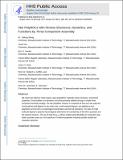| dc.contributor.author | Wang, Yufeng | |
| dc.contributor.author | Gu, Yuwei | |
| dc.contributor.author | Keeler, Eric George | |
| dc.contributor.author | Park, Jiwon | |
| dc.contributor.author | Griffin, Robert Guy | |
| dc.contributor.author | Johnson, Jeremiah A. | |
| dc.date.accessioned | 2018-01-26T16:35:49Z | |
| dc.date.available | 2018-01-26T16:35:49Z | |
| dc.date.issued | 2016-12 | |
| dc.date.submitted | 2016-11 | |
| dc.identifier.issn | 1433-7851 | |
| dc.identifier.issn | 1521-3773 | |
| dc.identifier.uri | http://hdl.handle.net/1721.1/113312 | |
| dc.description.abstract | We report star polymer metal–organic cage (polyMOC) materials whose structures, mechanical properties, functionalities, and dynamics can all be precisely tailored through a simple three-component assembly strategy. The star polyMOC network is composed of tetra-arm star polymers functionalized with ligands on the chain ends, small molecule ligands, and palladium ions; polyMOCs are formed via metal–ligand coordination and thermal annealing. The ratio of small molecule ligands to polymer-bound ligands determines the connectivity of the MOC junctions and the network structure. The use of large M 12 L 24 MOCs enables great flexibility in tuning this ratio, which provides access to a rich spectrum of material properties including tunable moduli and relaxation dynamics. | en_US |
| dc.description.sponsorship | National Science Foundation (U.S.) (Award CHE-1334703) | en_US |
| dc.publisher | Wiley Blackwell | en_US |
| dc.relation.isversionof | http://dx.doi.org/10.1002/ANIE.201609261 | en_US |
| dc.rights | Creative Commons Attribution-Noncommercial-Share Alike | en_US |
| dc.rights.uri | http://creativecommons.org/licenses/by-nc-sa/4.0/ | en_US |
| dc.source | PMC | en_US |
| dc.title | Star PolyMOCs with Diverse Structures, Dynamics, and Functions by Three-Component Assembly | en_US |
| dc.type | Article | en_US |
| dc.identifier.citation | Wang, Yufeng et al. “Star PolyMOCs with Diverse Structures, Dynamics, and Functions by Three-Component Assembly.” Angewandte Chemie International Edition 56, 1 (December 2016): 188–192 © 2017 Wiley-VCH Verlag GmbH & Co. KGaA, Weinheim | en_US |
| dc.contributor.department | Massachusetts Institute of Technology. Department of Chemistry | en_US |
| dc.contributor.department | Francis Bitter Magnet Laboratory (Massachusetts Institute of Technology) | en_US |
| dc.contributor.mitauthor | Wang, Yufeng | |
| dc.contributor.mitauthor | Gu, Yuwei | |
| dc.contributor.mitauthor | Keeler, Eric George | |
| dc.contributor.mitauthor | Park, Jiwon | |
| dc.contributor.mitauthor | Griffin, Robert Guy | |
| dc.contributor.mitauthor | Johnson, Jeremiah A. | |
| dc.relation.journal | Angewandte Chemie International Edition | en_US |
| dc.eprint.version | Author's final manuscript | en_US |
| dc.type.uri | http://purl.org/eprint/type/JournalArticle | en_US |
| eprint.status | http://purl.org/eprint/status/PeerReviewed | en_US |
| dc.date.updated | 2018-01-24T18:57:44Z | |
| dspace.orderedauthors | Wang, Yufeng; Gu, Yuwei; Keeler, Eric G.; Park, Jiwon V.; Griffin, Robert G.; Johnson, Jeremiah A. | en_US |
| dspace.embargo.terms | N | en_US |
| dc.identifier.orcid | https://orcid.org/0000-0002-1946-2913 | |
| dc.identifier.orcid | https://orcid.org/0000-0002-9604-7764 | |
| dc.identifier.orcid | https://orcid.org/0000-0003-1589-832X | |
| dc.identifier.orcid | https://orcid.org/0000-0001-9157-6491 | |
| mit.license | OPEN_ACCESS_POLICY | en_US |
